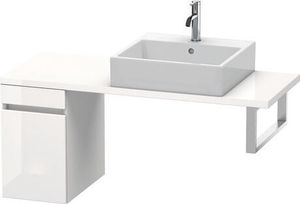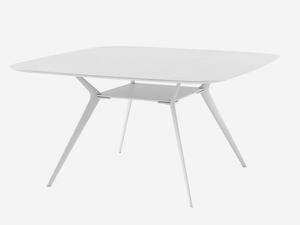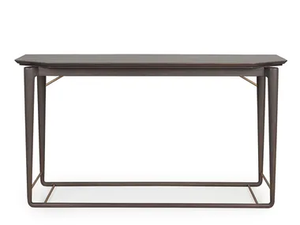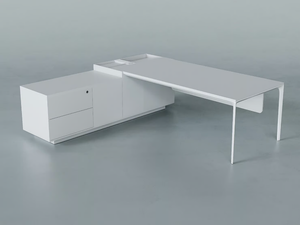coral move vision fr Terrain granite

forbo > Carpet
Coral Move Vision FR is a luxurious made-to-order floor covering, manufactured from 100% regenerated Econyl yarn, that offers the aesthetic styling, durability and long-lasting appearance retention required for heavily trafficked carriage interiors.• Durability and appearance retention due to 100% nylon construction• Reaction to fire EN 45545-2: HL2• High definition digital printing allows for extensive customisation possibilities and bespoke design• Natural latex backing from rapidly renewable source• Also available in a lightweight option at approx. 1.9 kg/m2
L-CUBE - VERO AIR C-BONDED - Wall-mounted sectional vanity unit with drawers _ Duravit

duravit > Washbasin cabinet
L-Cube Low cabinet for console

duravit > Washbasin cabinet
Number of drawers: 2, Without handle, Tip-on fitting, Soft self-closing automatic with damping, Incl. console: No Design by Christian Werner
DuraStyle Low cabinet for console

duravit > Washbasin cabinet
Compact, Number of pull-out compartments: 1, Without handle, Soft self-closing automatic with damping, Lay-in compartment: Optional, Incl. console: No Design by Matteo Thun & Antonio Rodriguez
URBAN LAUNDRY 02 - Laundry room cabinet with hinged doors with sink _ LEGNOBAGNO

LEGNOBAGNO > Cabinet
Chimera Radici Beige

florim > Wallcovering
In <em>Chimera,</em> Elena Salmistraro merges rigour with self-expression, in a graphic grammar laden with symbolic meaning. <em>Empatia </em>speaks to the emotions with graphics that interpret, through a highly individual abstract code, the stage make-up of a clown, with the aid of superimposed geometric forms and images. <em>Radici </em>is a tribal statement, a tribute to primitive ritual custom, evoked by the interplay between a sequence of triangles and rectangles and a set of figurative fragments. <em>Ritmo</em> is inspired by fabrics, suggesting the rhythmic alternation of woven yarns through a largely linear pattern. In <em>Colore, </em>the upheaval of a background of small isolated spots generated by a parametric digital program is combined with densely packed repeated forms. "The Chimera collection is rather like a book with four different chapters: I set out to differentiate these graphic motifs to create four totally different stories."<br></br>Elena Salmistraro It all starts with drawing. A <em>passion</em> for drawing. An <em>obsession</em> with drawing. Drawings like spider-webs, obsessively filling spaces, in a kind of manual choreography or gymnastics, a continuous flow. Elena Salmistraro draws all the time. She draws everywhere. Mostly on loose sheets or random surfaces. First and foremost with pen and pencil. Her drawings only acquire colour at a later stage. Often - just like Alessandro Mendini used to do - she draws "monsters": fascinating yet disturbing, subversive forms. The denser, more contorted the shape, the more obvious its underlying truth. For Elena, drawing is an intimate act. It is relaxing. And therapeutic. With an unrivalled communicative strength. Because drawing gives shape to ideas: you both give form to the world and reveal yourself. This passion, combined with natural graphic talent, has guided Elena Salmistraro in her project for Cedit: an experimental series of ceramic slabs produced using a high-definition 3D decorative technique. The explicit aim is to transform surfaces beyond their original flatness so that a new, visual and tactile, three-dimensional personality emerges, sweeping aside the coldness and uniformity that ceramic objects often inevitably convey.Elena Salmistraro has always viewed ceramics as a democratic material, in view of their accessibility, and the infinite potentials for shaping matter that they provide. She began working and experimenting with ceramics very early in her career, just after she graduated from the Milan Politecnico in 2008. She came into contact with small artistic craft firms specialising in smallproduction lots, and cut her teeth on projects that demanded the hand-processing of every detail, and finishes of high artistic value, for the high end of the market. The large corporations and galleries came later, but here again Elena kept faith with her desire to make mass-produced pieces unique, and to combine artistic value with specifically industrial characteristics. The monkey-shaped <em>Primates</em> vases reflect this method and intention, aiming to excite, surprise and charm. Antiminimalist and hyper-figurative, playful, ironic and a rich image-maker, often drawing on anthropology and magic, over the years Salmistraro has built up her own fantastic universe, inhabited by ceramic bestiaries, painted jungles and a cabinet like a one-eyed cyclops , always finding inspiration and inputs in nature and always aiming to reveal the extraordinary in the everyday. Given this background, it was almost inevitable she would work with Cedit: constantly seeking new talents and new approaches, as well as designs that break down the boundaries of ceramics and release them into the realm of art and innovation, the Modena company has recognised Elena Salmistraro as a leading contemporary creative spirit and involved her in a project intended to experiment with fresh ideas in materials and synaesthetics.Salmistraro's collection for Cedit is entitled <em>Chimera</em> and consists of large ceramic slabs, which can be enjoyed not only visually, through their patterns and colours, but also on a tactile level. Like the chimera in the "grotesque" tradition, monstrous in the etymological sense of the word with its merging of hybrid animal and vegetable shapes, the Cedit project attempts to originate a synaesthetic form of ceramics, through a three-dimensional development that exactly reproduces the texture of leathers and fabrics, creating an absolutely new kind of layered effect, with a tactile awareness that recalls the passion of grand master Ettore Sottsass for "surfaces that talk". And the surfaces of the slabs Salmistraro has created really seem to talk: in <em>Empatia </em>clown faces add theatricality to the cold gleam of marbles, interspersed with references to Art Déco graphics; <em>Radici</em> uses the textures of leathers and hide as if to re-establish a link between ceramics and other materials at the origins of human activity and creativity; in <em>Ritmo</em> the texture of cloth dialogues with pottery, almost in homage to the tactile rationalism of warp and weft, of which Bauhaus pioneer Anni Albers was one of the most expressive past interpreters ; finally, <em>Colore</em> has a spotted base generated by computer to underline the contrast between analogue and digital, the graphic sign and the matter into which it is impressed. It is an aesthetic of superimposition and mixing, and especially of synaesthesia: as in her drawings, in the <em>Chimera </em>slabs Elena Salmistraro's art is one of movement and acceleration. A process not of representation but of exploration. Of the world and of oneself. Almost a kind of Zen, for distancing oneself from the world to understand it more fully. In every sense.
Ausi Pendant

graypants > Ceiling lamp
Handcrafted from recycled cardboard, Graypants flagship Scraplights provide warm, intimate, and functional lighting for any occasion or space. Tough and elegant, each is precision cut with a laser and assembled by hand using non-toxic adhesive, and all Scraplights are treated with a non-toxic fire retardant.
GORDON ORIGINS - Leather armchair with armrests _ Crearte Collections

Crearte Collections > Armchair
LISBONA - Upholstered leather chair _ HESSENTIA | Cornelio Cappellini

HESSENTIA | Cornelio Cappellini > Chair
AMANDA 227/6 - Antique Brass chandelier with camber crackle glass _ Possoni Illuminazione

Possoni Illuminazione > Ceiling lamp
audrey

poliform > Styling
Audrey is a romantic and minimalistic mirror. The wall version enhances the soft edges and the thin frame, while the floor version highlights the particular detail work of the back and the refined metal support. The mirror is available in the light or the bronze version.






































